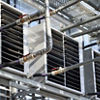World's largest solar-thermal sewage sludge drying system

Pressing more economical than welding
The general contractor in Rödinghausen handling the work, IRB Industrie-Rohrbau GmbH, believes that pressing the pipe connections of the thick-walled steel pipes "cold" instead of welding them in the conventional way achieved another decisive advantage going beyond what was generally expected of the pipeline system. Especially given the quantity structures coupled with extremely high loads involved here, this approach was far more economical, says IRB construction manager Michael Puckrandt: "We spend up to 80 percent less time on each connection joint compared to welding, depending on the nominal width. Despite the higher material costs in the full-cost pricing, this makes press connecting technology a very interesting proposition for us as the company implementing the work".
And how does the customer react, especially with a project of such an unusual nature, when there is no experience to fall back on? Master heating installer Puckrandt said: "Initially, every customer expects to see the result that was ordered. No matter whether this result is achieved by welding or by pressing. Here in particular, however, we checked in advance in close consultation with all those involved, also including Viega as the manufacturer, how the zinc nickel-coated connectors would behave in this installation environment, for example, or whether the press connection would definitely withstand the sometimes immense mechanical loads". The result is more than convincing, because in addition to the robust material properties, the connectors are reliably tight, even on the steel pipes coated in accordance with AGI Q151, with comparatively little preliminary and finishing work. "Under harsher conditions too", emphasises Michael Puckrandt: "Because extremely high forces are still acting on the connections on the main line. Nonetheless, even here and under changing external influences, the Megapress system has satisfied all the requirements so far."
For the general contractor from the German region of Westphalia, this makes the installation environment, which is as extraordinary as it is difficult under operating conditions, a reference project object that ultimately enhances a skilled welder's performance with cost-efficient, safe press connecting technology, says Michael Puckrandt: "For us, this is a tangible step towards a sustainable future. Because the problem of skilled labour is already acute in the pipeline installation sector. Good and experienced welders are increasingly difficult to find".
| Object | Solar-thermal sewage sludge drying plant |
| Location | Bottrop |
| Year | 2021 |
| Object Type | New building |
| Area of use | Industrial and commercial applications |
The "Emscher hybrid power plant" project
The solar-thermal drying system is part of the "Emscher hybrid power plant", which is expected to save up to 70,000 tonnes of CO2 per year from electricity generation by combining five renewable energy sources:
- a wind turbine with an output of 3.1 MW (inaugurated in April 2016)
- four new combined heat and power plant modules, each with an output of around 1.2 MW (commissioned in February 2017)
- a photovoltaic system covering approx. 500 m² (commissioned in February 2017)
- a steam turbine with a capacity of at least 4 MW (December 2017), and of course the
- solar-thermal sewage sludge drying system.
The Emschergenossenschaft, a water management company under public law, is backing the project. Founded in 1899 as the first organisation of its kind in Germany, the company has since then been handling the maintenance of the Emscher river, waste water disposal and purification as well as flood protection. Since 1992, the Emschergenossenschaft has been planning and implementing the inter-generation Emscher conversion project in close cooperation with the Emscher local authorities. Some 5.38 billion euros are expected to be invested in the project over a period of around 30 years.
Learn more: www.ewlw.de






